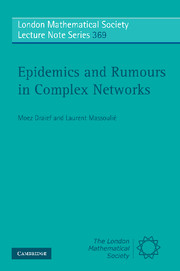Book contents
- Frontmatter
- Contents
- Introduction
- PART I SHAPELESS NETWORKS
- 1 Galton–Watson branching processes
- 2 Reed–Frost epidemics and Erdős–Rényi random graphs
- 3 Connectivity and Poisson approximation
- 4 Diameter of Erdős–Rényi graphs
- 5 From microscopic to macroscopic dynamics
- PART II STRUCTURED NETWORKS
- References
- Index
5 - From microscopic to macroscopic dynamics
Published online by Cambridge University Press: 25 January 2011
- Frontmatter
- Contents
- Introduction
- PART I SHAPELESS NETWORKS
- 1 Galton–Watson branching processes
- 2 Reed–Frost epidemics and Erdős–Rényi random graphs
- 3 Connectivity and Poisson approximation
- 4 Diameter of Erdős–Rényi graphs
- 5 From microscopic to macroscopic dynamics
- PART II STRUCTURED NETWORKS
- References
- Index
Summary
Introduction
So far we have dealt with microscopic models of interaction and epidemic propagation. If we are interested in macroscopic characteristics, such as the time before a given fraction of the population is infected, a simpler analysis is often possible in which we can identify deterministic dynamic models, specified by differential equations, that reflect accurately the dynamics of the original system at a macroscopic level. Such macroscopic description is referred to as mean-field approximation.
Differential equations (macroscopic models) and Markov processes (microscopic models) are the basic models of dynamical systems in deterministic and probabilistic contexts, respectively. Since the analysis, both mathematical and computational, of differential equations is often more feasible and efficient, it is of interest to understand in some generality when the sample paths of a Markov process can be guaranteed to lie, with high probability, close to the solution of a differential equation.
We shall provide generic results applicable to all such contexts. In what follows we approximate certain families of jump processes depending on a parameter n usually interpreted as the total population size, and we approximate certain jump Markov processes as the parameter n becomes large. It is worth mentioning that the techniques presented here can be applied to a wide range of problems such as epidemic models, models for chemical reactions and population genetics, as well as other processes.
- Type
- Chapter
- Information
- Epidemics and Rumours in Complex Networks , pp. 54 - 62Publisher: Cambridge University PressPrint publication year: 2009

